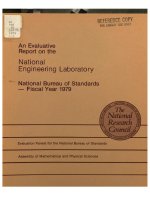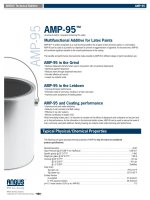C444 95
Bạn đang xem bản rút gọn của tài liệu. Xem và tải ngay bản đầy đủ của tài liệu tại đây (22.6 KB, 2 trang )
Designation: C 444 – 95
AMERICAN SOCIETY FOR TESTING AND MATERIALS
100 Barr Harbor Dr., West Conshohocken, PA 19428
Reprinted from the Annual Book of ASTM Standards. Copyright ASTM
Standard Specification for
Perforated Concrete Pipe1
This standard is issued under the fixed designation C 444; the number immediately following the designation indicates the year of
original adoption or, in the case of revision, the year of last revision. A number in parentheses indicates the year of last reapproval. A
superscript epsilon (e) indicates an editorial change since the last revision or reapproval.
This standard has been approved for use by agencies of the Department of Defense.
TABLE 1 Number of Rows of Perforations Required
1. Scope
1.1 This specification covers perforated concrete pipe intended to be used for underdrainage.
1.2 A complete metric companion to Specification C 444
has been developed—C 444M; therefore, no metric equivalents
are presented in this specification.
Internal Designated Diameter
Rows of Perforations
in.
4
6
8
10
12
14
15
16
18
20
21
24
27 and larger
2. Referenced Documents
2.1 ASTM Standards:
C 822 Terminology Relating to Concrete Pipe and Related
Products2
3. Terminology
3.1 Definitions—For definitions of terms relating to concrete pipe, see Terminology C 822.
4
4
4
6
6
6
6
6
8
8
8
8
space rows approximately 6 in.
and class of pipe specified, and by inspection to determine
whether the pipe conforms to this specification as to design and
freedom from defects.
4. Classification
4.1 Pipe manufactured according to this specification shall
be of two classes known as Type 1 and Type 2, which cover
two arrangements of perforations that may be used with pipe
manufactured according to any of the standard specifications
for plain or reinforced concrete pipe, and any of the classifications within those standard specifications.
4.1.1 Type 1 perforated pipe shall have circular perforations
conforming to 6.1 and Table 1.
4.1.2 Type 2 perforated pipe shall have slotted perforations
conforming to 6.2 and Table 2.
4.1.3 It is intended that perforated pipe shall be specified by
reference to this specification and the specification for the type
and class of pipe desired.
NOTE 2—It is intended that all tests will be applicable except those
having to do with permeability and the hydrostatic test.
6. Perforations
6.1 Type 1—Perforations shall be circular, not more than 5⁄16
in. or less than 3⁄16 in. in diameter, and arranged in rows parallel
to the axis of the pipe. Perforations shall be 3 in. center-tocenter, along rows. The spigot or tongue end shall not be
perforated for a length equal to the depth of the socket, or depth
of the groove plus 3⁄4 in. and perforations shall continue at
uniform spacing along the entire length of the barrel. The total
TABLE 2 Requirements for Length and Spacing of Slots
NOTE 1—Example “Perforated concrete pipe shall conform to the
requirements of Specification C 444 Type 2, and all applicable requirements of Specification C 14, Class 2.”
Internal Designated Diameter
Slot Length
Slot SpacingA
in.
in.
in.
4
6
8
10
12
14
15
16
18
20
21
24
27 and larger
1
11⁄2
2
2
3
3
3
3
3
3
3
3
4
3
3
4
4
6
6
6
6
6
6
6
6
6
5. Basis of Acceptance
5.1 The acceptability of the pipe shall be determined by the
results of all applicable tests (Note 2) prescribed for the type
1
This specification is under the jurisdiction of ASTM Committee C-13 on
Concrete Pipe and is the direct responsibility of Subcommittee C13.01 on
Nonreinforced Concrete Sewer, Drain, and Irrigation Pipe.
Current edition approved June 15, 1995. Published August 1995. Originally
published as C 444 – 59. Last previous edition C 444 – 94.
2
Annual Book of ASTM Standards, Vol 04.05.
A
1
See 6.2 for exceptions for plain-end pipe.
C 444
number of rows shall be as shown in Table 1. The rows shall be
spaced over not more than 165° of circumference. Rows shall
be symmetrically arranged with respect to the intended top or
bottom of the pipe.
6.2 Type 2—Slots shall be circumferential in direction, not
more than 3⁄16 in. or less than 1⁄8 in. in width, and of the lengths
shown in Table 2. There shall be two rows of slots, spaced 165°
apart, and centered, in the case of elliptically reinforced pipe,
about the minor axis of the reinforcing. Slots shall be spaced as
shown in Table 2, except as modified herein for plain-end pipe.
The distance from the spigot end, or from the shoulder of the
tongue end, to the first pair of slots shall be not more than 1 in.
greater than the specified slot spacing, nor less than 1 in. less
than the specified slot spacing. Slots shall continue at uniform
spacing along the length of the barrel.
6.2.1 Slots in plain-end pipe shall be spaced as shown in
Table 2 except that smaller spacing shall be used where
necessary to provide not less than three equally spaced slots in
each row. Slots shall be centered with respect to the ends of the
pipe and there shall be not more than the specified slot spacing
from the pipe end to the first pair of slots, or less than one half
of the slot spacing employed.
6.3 The manufacturer may submit to the owner for approval,
prior to manufacture, sizes and arrangements of perforations
other than specified herein.
9. Repairs
7. Joints
7.1 The joints shall be of such design and the ends of the
concrete pipe sections so formed that the pipe can be laid
together to make a continuous line of pipe compatible with the
permissible variations given in Section 8.
12. Rejection
9.1 Pipe may be repaired, if necessary, because of imperfections in manufacture or accidental injury during handling,
and will be acceptable, if in the opinion of the owner, the
repairs are sound and properly finished and cured and the
repaired pipe conforms to the requirements of this specification.
10. Marking of Rejected Specimens
10.1 All rejected pipe shall be marked clearly by the owner
and shall be replaced by the manufacturer with pipe that will
meet the requirements of this specification, without additional
cost to the owner.
11. Inspection
11.1 The quality of all materials and the finished pipe shall
be subject to inspection and approval by the owner. Such
inspection may be performed at the point of manufacture or
delivery. The method of marking as to acceptance or rejection
of the pipe shall be agreed upon, prior to inspection, between
the owner and manufacturer. Rejected pipe shall be replaced by
the manufacturer with pipe that meets the requirements of this
specification.
12.1 Pipe shall be subject to rejection on account of any of
the applicable causes for rejection listed for the type and class
of pipe specified, or on account of any of the following:
12.1.1 Variations in dimensions exceeding those specified in
Sections 6 and 8, or
12.1.2 Any spall more than 3⁄4 in. in diameter or 3⁄16 in. in
depth caused by making perforations or slots.
8. Permissible Variation in Dimensions
8.1 The permissible variation in circular perforation size or
slot width shall be as specified in Section 6. Slot length may be
varied + 1⁄4 in. or − 1⁄8 in. Variation in row spacing, or in the
spacing of holes or slots in any row, may be 61⁄2 in. except as
may be required to provide specified cover for reinforcing
steel.
13. Keywords
13.1 concrete pipe; perforated; subsurface drainage; underdrainage
The American Society for Testing and Materials takes no position respecting the validity of any patent rights asserted in connection
with any item mentioned in this standard. Users of this standard are expressly advised that determination of the validity of any such
patent rights, and the risk of infringement of such rights, are entirely their own responsibility.
This standard is subject to revision at any time by the responsible technical committee and must be reviewed every five years and
if not revised, either reapproved or withdrawn. Your comments are invited either for revision of this standard or for additional standards
and should be addressed to ASTM Headquarters. Your comments will receive careful consideration at a meeting of the responsible
technical committee, which you may attend. If you feel that your comments have not received a fair hearing you should make your
views known to the ASTM Committee on Standards, 100 Barr Harbor Drive, West Conshohocken, PA 19428.
2









